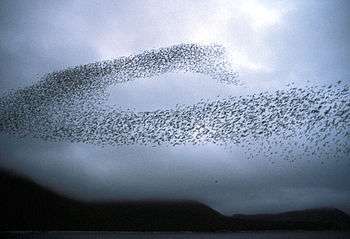Collective motion
Collective motion is defined as the spontaneous emergence of ordered movement in a system consisting of a large number of self-propelled agents. It can be observed in everyday life, for example in flocks of birds, schools of fish, herds of animals and also in crowds and car traffic. It also appears at the microscopic level: in colonies of bacteria, motility assays and artificial self-propelled particles.[1][2][3] The scientific community is trying to understand the universality of this phenomenon. In particular it is intensively investigated in statistical physics and in the field of active matter. Experiments on animals,[4] biological and synthesized self-propelled particles, simulations[5] and theories[6][7] are conducted in parallel to study these phenomena. One of the most famous models that describes such behavior is the Vicsek model introduced by Tamás Vicsek et al. in 1995.[8]
Collective behavior of Self-propelled particles
Just like biological systems in nature, self-propelled particles also respond to external gradients and show collective behavior. Micromotors or nanomotors can interact with self-generated gradients and exhibit schooling and exclusion behavior.[9] For example, Ibele, et al. demonstrated that silver chloride micromotors, in the presence of UV light, interact with each other at high concentrations and form schools.[10] Similar behavior can also be observed with titanium dioxide microparticles.[11] Silver orthophosphate microparticles exhibit transitions between schooling and exclusion behaviors in response to ammonia, hydrogen peroxide, and UV light.[12][13] This behavior can be used to design a NOR gate since different combinations of the two different stimuli (ammonia and UV light) generate different outputs. Oscillations between schooling and exclusion behaviors are also tunable via changes in hydrogen peroxide concentration.
Micromotors and nanomotors can also move preferentially in the direction of externally applied chemical gradients, a phenomenon defined as chemotaxis. Chemotaxis has been observed in self-propelled Au-Pt nanorods, which diffuse towards the source of hydrogen peroxide, when placed in a gradient of the chemical.[14] Silica microparticles with Grubbs catalyst tethered to them, also move towards higher monomer concentrations.[15] Enzymes also behave as nanomotors and migrate towards regions of higher substrate concentration.[16] One interesting use of enzyme nanomotor chemotaxis is the separation of active and inactive enzymes in microfluidic channels.[17] Another is the exploration of metabolon formation by studying the coordinated movement of the first four enzymes of the glycolysis cascade: hexokinase, phosphoglucose isomerase, phosphofructokinase and aldolase.[18] In general, chemotaxis of biological and synthesized self-propelled particles provides a way of directing motion at the microscale and can be used for drug delivery, sensing, lab-on-a-chip devices and other applications.
See also
Notes
- ↑ Palacci, Jeremie; Sacanna, Stefano; Steinberg, Asher Preska; Pine, David J.; Chaikin, Paul M. (2013-02-22). "Living Crystals of Light-Activated Colloidal Surfers". Science 339 (6122): 936–940. doi:10.1126/science.1230020. ISSN 0036-8075. PMID 23371555.
- ↑ Theurkauff, I., Cottin-Bizonne, C., Palacci, J., Ybert, C., & Bocquet, L. (2012). Dynamic clustering in active colloidal suspensions with chemical signaling. Physical Review Letters, 108(26), 268303.
- ↑ Buttinoni, I., Bialké, J., Kümmel, F., Löwen, H., Bechinger, C., & Speck, T. (2013). Dynamical clustering and phase separation in suspensions of self-propelled colloidal particles. Physical review letters, 110(23), 238301.
- ↑ Feder, Toni (October 2007). "Statistical physics is for the birds". Physics Today 60 (10): 28–30. doi:10.1063/1.2800090
- ↑ Grégoire, Guillaume; Chaté, Hugues (2004-01-15). "Onset of Collective and Cohesive Motion". Physical Review Letters. 92 (2): 025702. arXiv:cond-mat/0401208. Bibcode:2004PhRvL..92b5702G. doi:10.1103/PhysRevLett.92.025702.
- ↑ Toner, John; Tu, Yuhai (1995-12-04). "Long-Range Order in a Two-Dimensional Dynamical $\mathrm{XY}$ Model: How Birds Fly Together". Physical Review Letters. 75 (23): 4326–4329. Bibcode:1995PhRvL..75.4326T. doi:10.1103/PhysRevLett.75.4326.
- ↑ Chaté, H.; Ginelli, F.; Grégoire, G.; Peruani, F.; Raynaud, F. (2008-07-11). "Modeling collective motion: variations on the Vicsek model". The European Physical Journal B. 64 (3–4): 451–456. Bibcode:2008EPJB...64..451C. doi:10.1140/epjb/e2008-00275-9. ISSN 1434-6028.
- ↑ Vicsek, T.; Czirok, A.; Ben-Jacob, E.; Cohen, I.; Shochet, O. (1995). "Novel type of phase transition in a system of self-driven particles". Physical Review Letters 75 (6): 1226–1229. arXiv:cond-mat/0611743. Bibcode: 1995PhRvL..75.1226V. doi:10.1103/PhysRevLett.75.1226. PMID 10060237.
- ↑ Wang, W., Duan, W., Ahmed, S., Mallouk, T., & Sen, A. (2013). Small power: Autonomous nano- and micromotors propelled by self-generated gradients. NanoToday, 8(5), 531.
- ↑ Ibele, M., Mallouk, T., & Sen, A. (2009). Schooling behavior of light-powered autonomous micromotors in water. Angewandte Chemie International Edition, 48(18), 3308.
- ↑ Hong, Y., Diaz, M., Córdova‐Figueroa, U., & Sen, A. (2010). Light‐Driven Titanium‐Dioxide‐Based Reversible Microfireworks and Micromotor/Micropump Systems. Advanced Functional Materials, 20(10), 1568.
- ↑ Duan, W., Liu, R., & Sen, A. (2013). Transition between collective behaviors of micromotors in response to different stimuli. Journal of American Chemical Society, 135, 1280.
- ↑ Altemose, A., Sánchez-Farrán, M. A., Duan, W., Schulz, S., Borhan, A., Crespi, V. H., & Sen, A. (2017). Chemically-controlled spatiotemporal oscillations of colloidal assemblies. Angewandte Chemie International Edition. doi:10.1002/anie.201703239.
- ↑ Hong, Y., Blackmann, NMK., Kopp, ND., Sen, A., & Velegol, D. (2007). Chemotaxis of nonbiological colloidal rods. Physical Review Letters, 99, 178103.
- ↑ Ravlick, RA., Sengupta, S., McFadden, T., Zhang, H., & Sen, A. (2011). A Polymerization-Powered Motor. Angewandte Chemie International Edition, 50(40), 9374.
- ↑ Sengupta, S., Dey, KK., Muddana, HS., Tabouillot, T., Ibele, M., Butler, PJ., & Sen, A. (2013). Enzyme Molecules as Nanomotors. Journal of American Chemical Society, 135(4), 1406.
- ↑ Dey, Krishna Kanti; Das, Sambeeta; Poyton, Matthew F.; Sengupta, Samudra; Butler, Peter J.; Cremer, Paul S.; Sen, Ayusman (2014). "Chemotactic Separation of Enzymes". ACS Nano. 8 (12): 11941–11949. doi:10.1021/nn504418u. ISSN 1936-0851.
- ↑ Zhao, Xi; Palacci, Henri; Yadav, Vinita; Spiering, Michelle M.; Gilson, Michael K.; Butler, Peter J.; Hess, Henry; Benkovic, Stephen J.; Sen, Ayusman (2018). "Substrate-driven chemotactic assembly in an enzyme cascade". Nature Chemistry. 10 (3): 311–317. doi:10.1038/nchem.2905. ISSN 1755-4330.
Further references
- Bricard, A., Caussin, J. B., Desreumaux, N., Dauchot, O., & Bartolo, D. (2013). "Emergence of macroscopic directed motion in populations of motile colloids". Nature, 503 (7474): 95–98. doi:10.1038/nature12673
- Vicsek, T., & Zafeiris, A. (2012). "Collective motion." Physics Reports, 517 (3): 71–140. doi:10.1016/j.physrep.2012.03.004
External links
- Physicists come together to explore mechanics of collective motion The Guardian, 13 January 2014.
